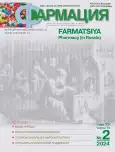Состав биологически активных веществ плодов клюквы обыкновенной (Oxycoccus palustris Pers.) различных способов консервации
- Авторы: Сергунова Е.В.1, Малышева М.О.1, Морохина С.Л.2, Самылина И.А.1
-
Учреждения:
- Первый Московский государственный медицинский университет им. И.М. Сеченова Министерства (Сеченовский Университет)
- РНИМУ им. Н.И. Пирогова
- Выпуск: Том 73, № 2 (2024)
- Страницы: 34-39
- Раздел: Фармацевтическая химия и фармакогнозия
- URL: https://bakhtiniada.ru/0367-3014/article/view/254096
- DOI: https://doi.org/10.29296/25419218-2024-02-05
- ID: 254096
Цитировать
Аннотация
Введение. Изучение плодов клюквы обыкновенной является перспективным, за счет большого разнообразия биологически активных веществ, входящих в их состав, широкого спектра терапевтических свойств, а также способности плодов клюквы к длительному хранению и устойчивости к жестким условиям внешней среды.
Свежие плоды содержат максимальное количество биологически активных веществ и, соответственно, обладают наиболее выраженным фармакологическим действием.
Для сохранения состава и содержания биологически активных веществ в фармации используется консервация. Чаще всего прибегают к высушиванию. Новым и перспективным способом для сохранения качества лекарственного растительного сырья может считаться замораживание
Цель исследования. Изучение влияния замораживания и высушивания на качественный состав и количественное содержание биологически активных веществ в плодах клюквы обыкновенной.
Материал и методы. Объектом исследования служили свежие, замороженные, высушенные плоды клюквы обыкновенной, собранные на территории Псковской и Новгородской областях в 2022 г. в период плодоношения. Изучение состава биологически активных веществ (БАВ) и количественную оценку содержания проводили по фармакопейным методикам, используя анализ с помощью тонкослойной хроматографии (ТСХ), спектрофотометрии и окислительно-восстановительные методы титрования.
Результаты. Методом ТСХ-анализа в плодах идентифицированы органические кислоты (аскорбиновая, яблочная, лимонная, винная и янтарная), флавоноиды (рутин, кверцетин), дубильные вещества (галловая кислота) и антоцианы. Различий в качественном составе у высушенных и замороженных плодов выявлено не было.
В плодах клюквы разных способов консервации определено содержание органических кислот, дубильных веществ, флавоноидов и антоцианов. Установлено, что при высушивании плодов происходит снижение содержания всех изучаемых групп БАВ, в среднем на 40–60% от исходного содержания в свежем сырье. Аскорбиновая кислота разрушается в большей степени (90–92%). Воздействие низких температур приводит к незначительному снижению БАВ в плодах клюквы обыкновенной (7–14%).
Заключение. Изучено влияние способов консервации на состав и содержание БАВ в плодах клюквы обыкновенной. Показана возможность использования замороженных плодов клюквы обыкновенной в качестве альтернативы свежему и высушенному сырью при изготовлении препаратов в аллопатии и гомеопатии.
Полный текст
Открыть статью на сайте журналаОб авторах
Екатерина Вячеславовна Сергунова
Первый Московский государственный медицинский университет им. И.М. Сеченова Министерства (Сеченовский Университет)
Автор, ответственный за переписку.
Email: srgvev@mail.ru
ORCID iD: 0000-0002-7194-5525
доктор фармацевтических наук, доцент, профессор кафедры фармацевтического естествознания Института фармации им. А.П. Нелюбина
Россия, 119991, Москва, ул. Трубецкая, д. 8, стр. 2Мария Олеговна Малышева
Первый Московский государственный медицинский университет им. И.М. Сеченова Министерства (Сеченовский Университет)
Email: srpskaya@bk.ru
ORCID iD: 0009-0001-6246-4439
студент Института фармации им. А.П. Нелюбина
Россия, 119991, Москва, ул. Трубецкая, д. 8, стр. 2Светлана Львовна Морохина
РНИМУ им. Н.И. Пирогова
Email: morohinas@mail.ru
ORCID iD: 0000-0003-1065-9610
кандидат фармацевтических наук, факультет подготовки кадров высшей квалификации
Россия, 117997, Москва, ул. Островитянова, д. 1Ирина Александровна Самылина
Первый Московский государственный медицинский университет им. И.М. Сеченова Министерства (Сеченовский Университет)
Email: samylina_i_a@staff.sechenov.ru
ORCID iD: 0000-0002-4895-0203
доктор фармацевтических наук, член-корреспондент РАН, профессор, профессор кафедры фармацевтического естествознания
Россия, 119991, Москва, ул. Трубецкая, д. 8, стр. 2Список литературы
- Государственная фармакопея Российской Федерации XIV издание. Федеральная электронная медицинская библиотека. URL: http://www.femb.ru/femb/pharmacopea.php (дата обращения: 20.10.2020).
- Лютикова М.Н., Ботиров Э.Х. Состав и практическое применение ягод брусники и клюквы. Химия растительного сырья. 2015; 2: 5–27.
- Лютикова М.Н., Туров Ю.П. Компонентный состав свежих, мороженых и подснежных ягод клюквы (Oxycoccus palustris). Химия растительного сырья. 2011; 4: 231–7.
- Марсов Н.Г. Фитохимическое изучение и биологическая активность брусники, клюквы и черники: автореф. дис. ... канд. фарм. наук. Пермь, 2006; 24.
- Новиков В.С., Губанов И.А. Популярный атлас-определитель. Дикорастущие растения. 5-е изд., стереотип. М., 2008; 415.
- Яшин А.Я., Яшин Я.И., Липеева А.В. Клюква: химический состав, биологическая активность и перспективы фармацевтического применения. Лаборатория и производство. М.: Изд-во ООО «ЛабПро Медиа», 2022; 3–4: 56–69.
- Guay D.R. Cranberry and urinary tract infections. Drugs. 2009; 69: 775–807.
- Côté J., Caillet S., Doyon G., Sylvain J-F., Lacroix M. Bioactive compounds in cranberries and their biological properties. Critical Reviews. Food Science and Nutrition. 2010; 50: 666–79.
Дополнительные файлы















